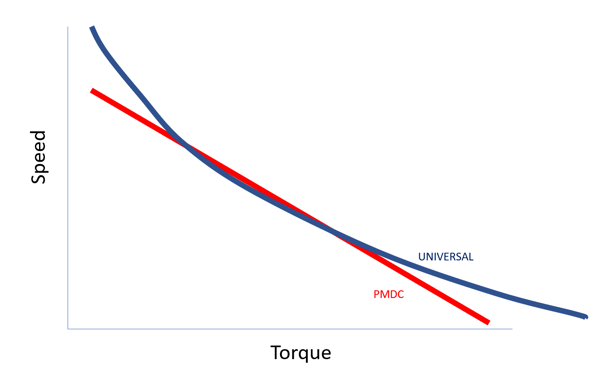In the world of motors, one of the most-used designs is called the universal motor. Basically, these motors are wound-field DC motors, where the armature and field are in series, and the current is switched using a commutator and brushes. But what makes it “universal?”
Universal motors will run on either AC or DC current. While the ability to run on either AC or DC is inherent, it is generally not a deciding factor for product designers. Typically, designers are more concerned about the voltage level. Low voltage appliances (12, 24, 36v) that use batteries to run are typically DC. High voltage motors (120v, 220/230/240v) that run from the power grid are typically AC. But at a given voltage, the universal motor can handle either.
What Makes Universal Motors Popular?
- Price. They are relatively inexpensive to manufacture because they have no electronic control boards.
- Output Power. They deliver about the highest amount of output power per pound of active material, iron and copper.
- High Starting Torque. They do not require capacitors or other circuits in order to start.
- Speed-Torque Curve. They have a downward sloping speed-torque curve, with speed increasing rapidly as the motor unloads. This makes them very well-suited for air moving applications, especially vacuum cleaners and pressure sprayers. In vacuum cleaners, this speed increase with decreasing load helps to compensate for dust filters as they clog up, allowing the appliance to maintain performance for longer.

- Simplicity. They are simple to wire up, as the motor itself does not have a polarity. If you do have colored leads, follow normal wiring conventions. (The motor may have a thermal protector, which should always be on the hot lead). But the motor itself does not care.
Life
The life span for universal motors varies widely depending on the application, design and power level, between 50 and 3,000 hours. These motors use carbon brushes and commutators as sliding switches to deliver power to the armature coils as the motor rotates. The carbon brushes do erode with time due to mechanical friction and electrical wear.
Brushes can be service items depending on how the manufacturer designs the product. Because the commutator also wears some during life, universal motors cannot be rebrushed indefinitely. Usually a second set of brushes will get about half the life of the original. Other components can also fail; bearings, electrical opens or shorts, and mechanical components. But if the motor is kept clean and vibration is not severe, these are relatively rare failure modes.
AMETEK DFS universal motors have a number of innovative brush features; special material grades, custom brush mechanisms and the patented Eternity curved brush to enhance life.
Moving Air
As mentioned above, one of the most popular uses for universal motors is in vacuum motors and blowers. In this case, the shaft is coupled to one or more fans or blower wheels. You may have noticed that new vacuum cleaner motors are much smaller and more compact than old ones. This is a trend in the vacuum motor industry. Remember a little motor theory:
OUTPUT POWER = OUTPUT SPEED x TORQUE
If you can raise the speed, you can get the same output power with less torque. And torque translates directly into material. As a result, today’s vacuum motor probably runs twice as fast as your grandmother’s and is much smaller and lighter. But to be able to do this, motor manufacturers have had to develop better bearings, commutators, brushes and fans that can handle the high speeds. They have also upped their game when designing the motor steel punchings to be more efficient in delivering speed and torque tailored to the needs of the market.
Manufacturers of air moving motors such as AMETEK DFS have taken advantage of these universal motor characteristics to supply a wide range of options, delivering a combination of motor air performance, size, weight, life and cost. Fan systems from one to six stages are available to meet a range of airflow and pressure/vacuum targets.

Shaft Drive
Some applications require a mechanical connection to the outside world to deliver power to another shaft, like a pulley or a cog. Or it may operate a load on the shaft that the operator does not want to run too fast; think of a string trimmer or a power tool. The universal motor has still been able to reduce weight and cost using more efficient punchings and higher temperature insulating materials that will hold up with less copper to dissipate heat.
Speed Control
The speed of a universal motor varies with the voltage. In special setups, you can use a variable AC transformer (“variac”) to adjust the performance for bench use. (NOTE: Do not exceed the rated voltage on the motor. Shortened life or motor damage may occur.)
For a more permanent solution, a TRIAC can be used along with a variable resistor or potentiometer to provide speed control by notching the wave form. This is effective for controlling speed, but it also shortens brush life. Other methods such as pulse width modulated DC voltage can also be used.
In some cases the motor field can be wound to permit a low speed, either by switching the field coils — from in series with each other to in parallel — or by putting a fixed tap in the field that can switch the strength of the magnetic field and vary the performance.
Environment
Universal motors come in many mechanical designs. All need to isolate the electrical part of the motor from environmental debris and moisture. They need clean air to cool the coils. Improper cooling is a frequent contributor to shortened life.
Some universal motors, called through-flow motors, are cooled by the working air. Others, called bypass motors, have a separate cooling fan which routes different air through the motor and across the coils. The working air bypasses the electrical side of the motor. They are the design of choice if the fan system is exposed to moist air. When providing cooling air for bypass motors, the product designer must be careful not to recirculate cooling air that could build up heat with each pass through the system. The motor manufacturer typically has an application note for this purpose.
If the motor is used in a vacuum cleaner application, it should be filtered before passing through the fan system, unless specifically designed to pass dirt and debris. If dust or debris sticks to fan blades, it can build up unevenly and cause vibration. High vibration can cause the brushes to bounce and arc, shortening brush life and damaging the commutator. It can also damage the bearings.
Conclusion
Universal motors definitely have a place in a variety of applications. Before simply plugging in a universal motor, it's important to understand what the application needs from the motor, and how the motor will react in certain environments.
At AMETEK Dynamic Fluid Solutions, we understand you’re looking for more than just an off-the-shelf part or one-time solution. You need a true technology partner who understands your engineering challenge and is focused on providing you customized, collaborative solutions. We’ll also provide you with excellent customer service for a great total experience. Visit www.ametekdfs.com for more information. You can also phone +1 330-673-3452 or email dfs.information@ametek.com.






